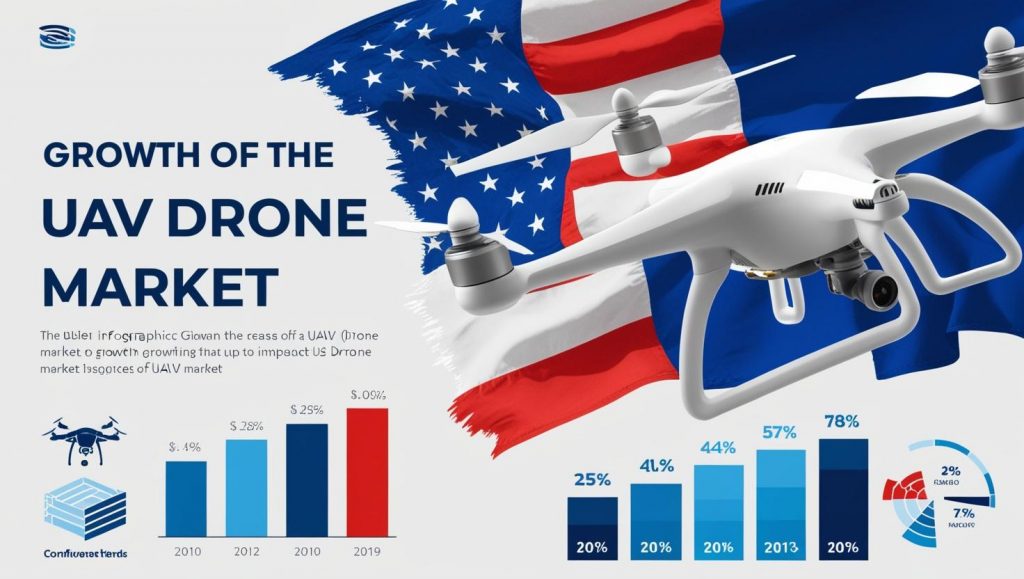The U.S. UAV (drone) industry stands at a pivotal point. While tariffs imposed on Chinese drones disrupted the status quo, they also unlocked opportunities for reinvention. Now, with shifting global supply chains, rising security standards, and growing regulatory clarity, the next phase of UAV growth depends not just on policymakers—but on businesses.
This blog explores how companies across sectors can actively fuel market expansion, foster resilience, and drive long-term innovation in the post-tariff drone economy.
Book Your “Trump Tariff Threat Assessment” @
https://www.marketsandmarkets.com/forms/ctaTariffImpact.asp?id=662
📊 UAV Market Outlook: A Rebounding Trajectory
Despite short-term turbulence from tariffs and trade restrictions, the global UAV market is expected to grow from $30 billion in 2023 to over $65 billion by 2030, according to industry forecasts.
Key Drivers of Growth:
-
Enterprise adoption in logistics, agriculture, energy, and construction.
-
Defense and homeland security demand for surveillance and reconnaissance UAVs.
-
AI integration and autonomous flight systems.
-
New regulatory frameworks like BVLOS and Remote ID unlocking scale.
But here’s the catch: this growth won’t happen automatically. Businesses must lean in strategically to shape the market’s next chapter.
🔑 1. Invest in Domestic Manufacturing & Supply Chain Resilience
With Chinese UAVs subject to tariffs and increasing scrutiny, the door is wide open for American and allied suppliers to scale.
Action Steps for Businesses:
-
Collaborate with U.S.-based UAV manufacturers like Skydio, Freefly, or Inspired Flight.
-
Develop alternate component partnerships in countries like South Korea, Taiwan, and Canada.
-
Support localized assembly or final-mile integration facilities to reduce import dependency.
📈 Forecast Insight: By 2027, North America’s share of UAV manufacturing could increase by 15–20% if businesses invest in localized supply networks.
🔐 2. Emphasize Cybersecurity & Compliance
Data privacy and national security concerns are now top buying criteria—especially for government and enterprise customers.
Business Opportunities:
-
Create end-to-end secure UAV platforms (hardware, firmware, cloud).
-
Offer compliance-as-a-service for companies navigating FAA, NDAA, or NIST standards.
-
Integrate onboard encryption, airspace awareness, and secure communication systems.
🔐 Forecast Insight: By 2030, 60% of commercial drone contracts in the U.S. will include explicit cybersecurity requirements.
🌐 3. Expand Use Cases with Industry-Specific Solutions
Generic UAVs are no longer enough. Growth will be driven by tailored applications that deliver measurable ROI in industry verticals.
Key Sectors to Watch:
-
Agriculture: multispectral imaging, crop health analysis, autonomous spraying.
-
Energy & Utilities: pipeline inspection, solar farm monitoring, asset lifecycle tracking.
-
Logistics: warehouse mapping, last-mile delivery, inventory management.
-
Public Safety: crime scene reconstruction, emergency response, disaster mapping.
🚀 Forecast Insight: Vertically integrated UAV solutions will outpace general-use drones by 2.5x in enterprise spending by 2028.
📜 4. Navigate Regulations Proactively
The FAA and other global regulators are moving quickly. Businesses that adapt early will lead.
Strategic Actions:
-
Pilot BVLOS operations and apply for FAA waivers.
-
Adopt Remote ID tech ahead of compliance deadlines.
-
Collaborate with policymakers to help shape urban air mobility (UAM) frameworks.
⚖️ Forecast Insight: U.S. UAV companies with regulatory-ready fleets will be 40% more likely to secure large contracts by 2026.
💼 5. Foster Public-Private Partnerships & Innovation Ecosystems
From funding R&D to co-developing infrastructure, the private sector can drive industry-wide innovation.
Key Enablers:
-
Partner with universities and incubators for drone AI, edge computing, and battery tech.
-
Co-sponsor drone corridors, test sites, or smart city drone zones.
-
Join initiatives like the FAA UAS Integration Pilot Program or Blue UAS framework.
🤝 Forecast Insight: Public-private UAV pilot zones can reduce tech-to-market time by 30–50% compared to unstructured R&D.
📣 Final Thought: Seize the Post-Tariff Momentum
Tariffs were a disruption—but also a strategic inflection point. With proactive investment, smart compliance, and industry-aligned innovation, businesses hold the key to propelling UAV growth through the rest of the decade.
Whether you’re a manufacturer, software company, logistics provider, or investor—this is the moment to build, not wait.

